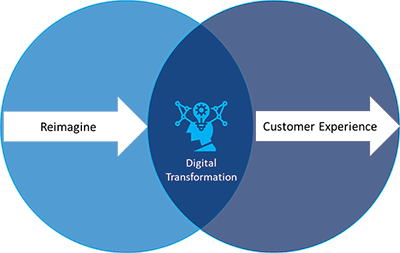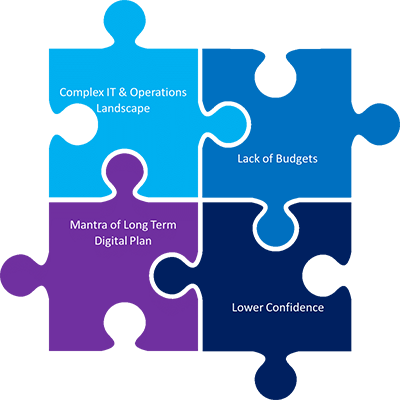BPM Analytics
How are Capital Markets pacing with Digital Transformation?
Capital markets once enjoyed higher profit margins and shined bright in the economic index of the country. The 2008 crisis, however, changed everything for financial services organizations. The credit crisis forced regulators around the world to closely monitor and impose strict regulations that demanded higher budgets, attracted greater fines/penalties, while revenues were stretched due to restrictions on proprietary trading.
While capital market players struggled with shrinking profit margins due to higher costs, fintech companies started filling the gap by offering superior customer experience with simplified digital processes. It came as a real challenge to the incumbent financial services companies and forced an outlook towards digital adoption. Given the complex IT landscape and operating models of traditional companies, the transition to digital must be precise and must be for the long term.
The COVID-19 pandemic has further fueled the “Digital First” calls across the capital market industry, primarily to bring in more efficiency, transparency, and higher savings on costs.

Why Digital?
Why has digital become a buzzword? Because it fundamentally transforms the core of a business, enabling it to see more, observe more, be agile in making decisions, and be hyper-productive in output. Digital has the power to revitalize outmoded systems and nurture them to become a sentient and responsive organization – a Live Enterprise.
Reimagining the existing IT landscape and operating models with cutting edge digital levers can significantly contribute to achieving higher cost-saving and maximizes efficiency. More importantly, digitization can enable a dynamic value delivery landscape to adopt future changes.
However, the overall adoption rate of digital is very low in the Capital Markets industry when compared with other industries, primarily due to complex IT stacks and the nature of products (Exchange vs OTC), ever-changing regulations, and lower profit margins. The benefits of a digital-first and consumer-first approach is gradually being realized in the Capital Markets industry, especially in a credit crisis situation, to bring down operational costs and enhance efficiency levels at speed and with accuracy.
Intelligent Automation, for instance, is being used by businesses to reduce manual intervention and operational risks. Digital automation also sits perfectly well with the core typical requirement of such an industry – uninterrupted service. New technologies, such as artificial intelligence, machine learning, and blockchain, are increasingly finding a way in the areas of reconciliation, static data update, instructions update, to some extent in settlements, client offboarding analysis, and so on.
The adoption of aggressive change management and emerging digital solutions enabled some institutions to achieve better STP, or digital operations transformation, by partnering with proven industry technologies, intelligent automation, and in-house IT talent. BNY Mellon, for example, implemented approximately 300 bots in production, Morgan Stanley built an AI-powered chatbot, BlackRock brought the Aladdin.
Long way to go…
While financial institutions are venturing into digital transformation with all gusto, a few pivotal processes, such as KYC, reference data and instrument data management, regulatory operations, etc. are still struggling to achieve meaningful digital transformation. We attempted to identify the primary reasons for un-satisfactory digital transformation projects:

Complex IT and Operations Landscape:
Capital markets industry is a complex web of multiple point solutions and legacy architecture. These legacy systems are vulnerable to even small interruptions, causing huge expenses, regulatory violations, and damaged reputation in many cases. This stigma further prevents leaders to initiate digital adoption.
Lack of Budgets:
Ongoing regulatory remediation programs, handling of additional costs related to operational risks also considerably shoot up expenses for companies, further squeezing profits. Such a scenario can put leaders in a position of dilemma regarding digital transformation.
Low Confidence:
Various research reports point out that CXO consider digital transformation as the number one necessity as well as a risk, but about 70% of the digital initiatives did not reach their goals. Lack of confidence at the implementation stage is the primary concern here. It is, therefore, the top priority for digital service providers to boost the confidence levels of the service receivers, engaging and guiding them from the start and owning the program.
Mantra for a Long-Term Digital Plan:
As the secondary research showed, 70% of the digital initiatives did not reach their goals due to long term plans and budget restrictions. Digital adoption needs balanced and phased planning to achieve the predefined goals. Leveraging the services partners ecosystem to implement future-proof transformation can prove to be just the answer here. While the digital expertise of a service provider implements digitalization at scale, financial institutions can focus on revolutionizing their core business with improved customer experience.
There’s no doubt that capital markets firms have a higher investment appetite for cloud, advanced analytics, and RPA. The bottom line to note for industry leaders is to prioritize digital transformation as a strategic imperative across front, middle, and back-office processes. The capital market industry is already spending over 60% of revenues to handle end-to-end services with limited profit margins, hence it is important for financial service institutions to build strong digital collaboration and strategy not just to maximize profits, but also to improve customer experience in the new digital era.






